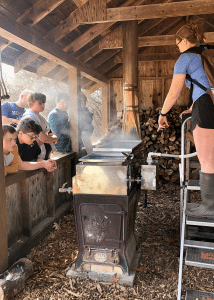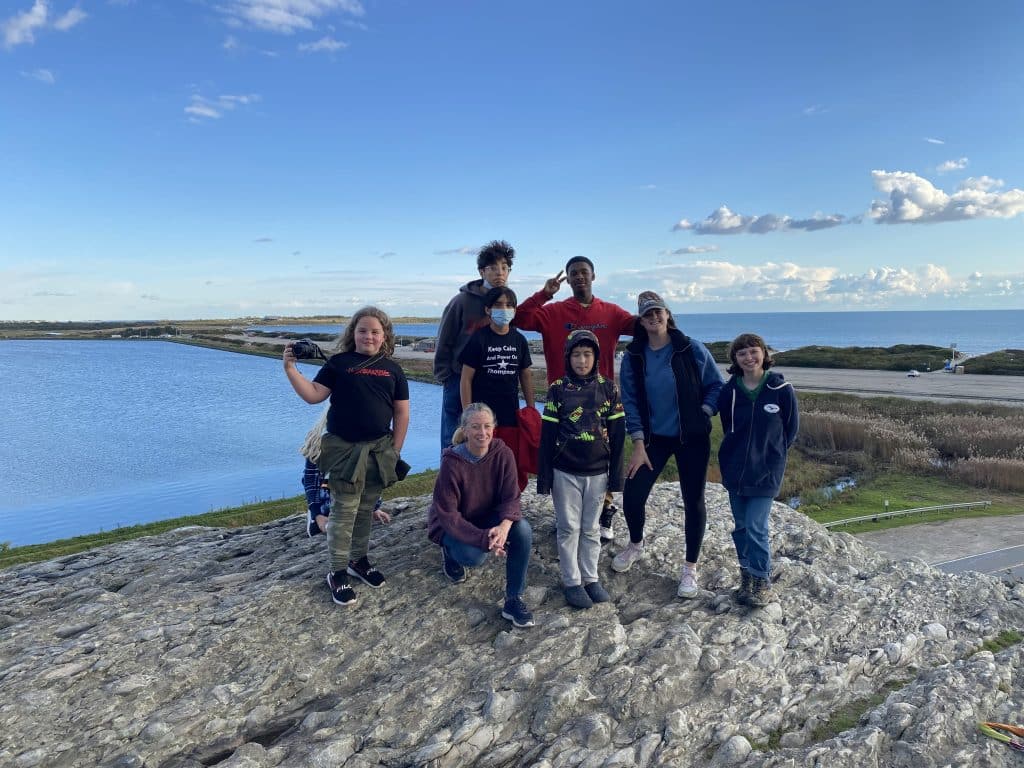How Schools Are Infusing Trust, Autonomy, and Relevance into Learning
CompetencyWorks Blog
What if schools were designed around the learner, not the system? What if education didn’t start with a curriculum, but with curiosity? Across the country, a growing number of educators and communities are answering these questions by embracing a learner-centered approach—one that prioritizes trust, relevance, and agency. Education Reimagined offers five essential elements that shape this vision: learner agency; socially-embedded; personalized, relevant, and contextualized; open-walled; and competency-based.
Education Reimagined’s framework aligns with Aurora’s definition of competency-based approaches to education as they both center learner ownership and choice, multiple pathways, rigorous, common expectations, and evidence of mastery over seat time.
In part one, we explored how competency-based education empowers learners to demonstrate mastery in meaningful ways. In this next piece, we’ll take a deeper look at how the other four elements show up in transformational ways. Although each element can be observed individually, they all work together to create a learning experience where young people are seen, heard, and empowered to take ownership of their learning. Across the country, schools and programs are redefining what education can look like when young people are trusted as co-creators of their learning journey.
Learner Agency

While learner-centered education can take on many forms, learner agency is a cornerstone element of a fully learner-centered experience. The goal of learner agency is for young people to develop into responsible citizens who are empowered to shape their own learning journeys and their lives with and in service of others. Learner agency is not necessarily about doing your own thing, as depicted in Lord of the Flies. Rather, it is about pursuing your interests within a supportive and flexible structure.
At Norris School District, a public school district in Mukwonago, Wisconsin, building a culture of agency begins even before learners’ first day. During their pre-enrollment interviews, educators listen carefully to prospective students and help them identify where they might find excitement and connection on campus. Opportunities that promote learner agency also begin on the first day of orientation. As new learners tour the campus, they are encouraged to stop and ask people questions, explore spaces, join a conversation, or even partake in a meeting initially intended for just the educators.
Many learners at Norris and other learner-centered environments may not be accustomed to having any agency in a school setting, so for them to truly act with agency, it must be grounded in trust. Throughout the first 30 days of enrollment, learners partner with the educators at Norris, who help them say “yes” to their aspirations through the creation of a plan for their learning journey. Even seemingly small practices, like being able to add meetings to any staff member’s online calendar, create an environment where supportive adults are accessible. Building relationships upfront changes the conventional teacher-student power dynamic to create a space where learners and educators respect each other mutually.
Socially-Embedded
If you grew up in the 90s, or know a young person who did, you’re likely familiar with the character of Mr. Feeny from Boy Meets World—a wise and caring teacher who connects with each student in a personal and meaningful way. Now, imagine if every learner had a “Mr. Feeny” in their learning environment that took the time to personally know and engage with each learner. That’s the idea behind a socially-embedded learning environment. The socially-embedded element is the intentional fostering of relationships among members of a learning community so that each person is known and welcome to bring their whole self to each interaction.
For learning experiences to be socially-embedded, each learner needs to be truly known—from the colors and foods each younger learner enjoys, to the skills and career aspirations of older learners, as well as everything in between. As Coi Morefield, founder and CEO of The Lab School of Memphis reflects, “Being yourself is a great thing.” In The Lab School—a micro-school in Memphis, Tennessee—creating a culture that embraces this sentiment begins with their orientation for staff, during which team members host workshops for each other to share their skills and areas of expertise.
Like the learners, educators (known as “guides”) are also centered as full human beings. As part of their professional development, the school even brings in life and wellness coaches to support the guides. This focus on nurturing the whole person extends to the entire Lab School community. By taking care of each other and learning together, the adults tend to a culture of care for themselves and their learners. Youth at The Lab School seem to embrace this culture—a young learner once shared with a visitor, “This is not my school. This is my home.”
Personalized, Relevant, and Contextualized
Personalized, relevant, and contextualized learning can be seen as Jedi train throughout the Star Wars franchise. Each Padawan—a young Jedi in training— has a journey shaped by their unique strengths, struggles, and connection to the Force. Jedi mentors tailor their teaching to the needs and experiences of their Padawan. Lessons happen in real time, often in the field, and are rooted in real stakes and lived experiences. Jedi learn through relevant, immersive practice that blends physical skill, emotional intelligence, and self-discovery. The Force may bind the galaxy together, but the path to mastering it is anything but standard.

Sometimes, young people only explore things they think they are good at or what an adult tells them they should do. Learner-centered environments aim to help young people discover what talents they have and what they enjoy by creating experiences in which they can authentically create, learn, and grow. During FabNewport’s summer program, learners have the opportunity to partake in a wide range of activities, exploring various areas of interest by completing three, 2-week-long exploration sessions. These areas can range from farming and surfing to woodworking and sailing.
As with many learner-centered environments, multiple elements of learner-centered education are working in harmony at once. For example, the composition of the learning teams is designed to be personalized, contextualized, and relevant while also expressing the socially-embedded element with each group consisting, ideally, of an adult team leader, a college-aged assistant, two high school navigators, and six middle schoolers.
Open-Walled
Nothing screams “open-walled learning” quite like The Magic School Bus. With her shape-shifting bus and trusty lizard Liz, Miss Frizzle, voiced by Lily Tomlin, takes her learners on adventures across the globe and even inside the human body. While Dorthy Ann complains about how things weren’t this way at her old school, the others delight in getting out of the classroom for hands-on learning.
But open-walled learning is more than just field trips: it’s an approach and understanding that the world is the classroom. At LaFayette Big Picture—part of the Big Picture Learning network—twice-weekly internships are a core part of its model, but these internships do not start on day one. Rather, first-year learners participate in service opportunities, such as volunteering at a local soup kitchen. Throughout these service experiences, educators are observing the learners. They are looking for durable skills and seeing how learners manage themselves and their time. Educators also observe how the learners are interacting with adults and if they meet goals by committing to and completing tasks.
These informal assessments help learners and educators at LaFayette evaluate what work and skills will need to be established, if any, before a young person can take on an internship with more independence. Usually, after a month or so of service work, a few learners can start shadowing at internship sites to see if any appeal to their interests. For the learners who are not quite ready, educators support them at school through different opportunities with the goal of preparing them to take on a full-length internship. As always, this learning is mapped back to a young person’s learning goals.
When Learners Lead
Together, the learner-centered elements illuminate what’s possible when education is centered around each individual learner. When taken as a whole, they represent more than just practices; they form a mindset grounded in trust, connection, and purpose. Across the country, learner-centered communities are proving that when young people are given the space, support, and responsibility to shape their education, they don’t just learn more—they thrive.
You can read more about Education Reimagined’s five key elements of learner-centered education in the “Learner-Centered in Focus” report.
 Jason Krobatsch is Education Reimagined’s Senior Manager of Content Development, bringing a decade of experience in communications, including five years in education. Passionate about amplifying learner-centered innovation, he has helped elevate the stories of over 100 educators, young people, and thought leaders working to create a public education system that serves today’s youth. When he’s not wordsmithing, you can find him listening to a podcast, watching ice hockey, enjoying a Broadway show, or sitting around a campfire with friends.
Jason Krobatsch is Education Reimagined’s Senior Manager of Content Development, bringing a decade of experience in communications, including five years in education. Passionate about amplifying learner-centered innovation, he has helped elevate the stories of over 100 educators, young people, and thought leaders working to create a public education system that serves today’s youth. When he’s not wordsmithing, you can find him listening to a podcast, watching ice hockey, enjoying a Broadway show, or sitting around a campfire with friends.